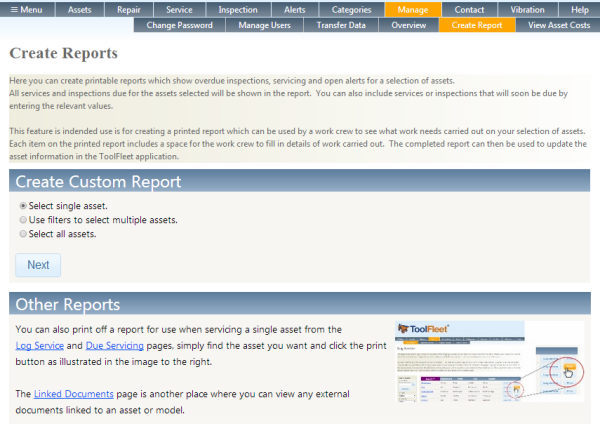There’s a good chance you’re already using some kind of paper forms to gather information about your assets. It’s a good idea to have detailed inspection checklists for as much of your machinery and equipment as you can. These forms are used by your field staff and engineers, and the design of your forms varies considerably, depending on the type of assets. A forklift inspection checklist is, for example, very different to that of a generator. The completed forms are stored on file, after any ‘action points’ (eg, defects) have been logged in ToolFleet.
If you don’t already have one, you might want to download this vehicle inspection checklist. It’s in MS Word format, so you can adapt it to your own needs.
 ToolFleet can generate printer-friendly reports (e.g. listing all the assets needing attention at a particular location), which you can dish out to your staff (or they can print them off themselves). This is handy for various situations:
ToolFleet can generate printer-friendly reports (e.g. listing all the assets needing attention at a particular location), which you can dish out to your staff (or they can print them off themselves). This is handy for various situations:
- You probably have a good number of staff who aren’t exactly tech-savvy. They will be a lot happier filling in data on paper, than struggling to type on a keyboard. They can hand their paper forms to your admin staff, who can then batch the data off the paper forms, into ToolFleet.
- You might have field staff who are tech-savvy, but are up to the elbows in grease and mud. It would be a poor idea for them to get a computer (or smartphone) all covered in muck as well – paper is cheaper and more forgiving!
- Your staff might be going to places where there’s no internet connection.
- If you outsource repairs and maintenance to other engineering companies or garages, then handing them a paper form with a list of EXACTLY what you want them to do, can be useful. They can fill the form in, and hand it back to you when you return to pick up your vehicle/machine.
1. Management tips, for successful implementation of your maintenance system.
2. Set up new users’ accounts.
3. Upload your logo.
4. Give all your assets a unique ID.
5. Setting up ‘categories’.
6. Add your assets individually, or upload multiple assets in a batch.
7. Set up your inspection and service intervals for each different model.
8. Fit hour-meters to any assets that don’t have them.
9. Times when you might want to make use of paper forms, instead of keying data in directly.
10. Admin tips.




